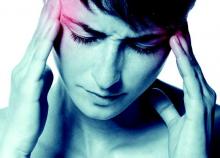SCOTTSDALE, ARIZ. - The first randomized, controlled trial of behavioral weight loss as a treatment for migraine in women is underway, with results expected in mid-2016.
The trial “provides an empirical framework for the recent clinical recommendation that behavioral weight loss strategies be incorporated within treatment plans for patients with migraine and obesity,” said principal investigator Dale Bond, Ph.D., of the department of psychiatry and human behavior at Brown University, Providence, R.I.
Prior research has repeatedly linked obesity to more frequent and severe migraine attacks and worse headache-related disability, but results from the Women’s Health and Migraine (WHAM) trial could help clinicians to motivate patients with migraine to actually lose weight, Dr. Bond said at a symposium sponsored by the American Headache Society.
For the single-site trial, investigators are randomizing overweight and obese female migraineurs aged 18-50 years to either a 16-week behavioral weight loss intervention or to a migraine education control condition, Dr. Bond said. Patients are selected by a “rigorous” 60-minute phone interview and must have had no changes in their headache medications for at least 2 months before the start of the study, he added.
Both groups are using smartphones to record headaches for 4 consecutive weeks during three time periods: at baseline, immediately after the 16-week treatment or control period, and after a 16-week nontreatment follow-up period. “This is one of the more innovative features of this trial – we can look at the data in real time, and if they don’t complete diary, we can prompt them,” Dr. Bond said.
Women in the behavioral weight loss group are asked to lose at least 7% of their initial body weight by weighing themselves daily and recording what they eat, following a 1,200- to 1,500-calorie diet with no more than 25% of calories from fat, attending group meetings, and engaging in moderate to vigorous exercise for at least 250 minutes per week. Participants wear armband pedometers that monitor their physical activity. They also are undergoing behavioral therapy focused on controlling stimuli to eat and learning to set goals and develop problem-solving skills, he added.
In contrast, the control condition “provides the same amount of therapist attention, but no active intervention strategies to produce weight loss,” Dr. Bond said. “We’re using this condition to control for the amount of therapist contact,” he added. These individuals are attending education sessions about migraine, stress, communication with health care providers, relaxation techniques, cognitive restructuring, healthy eating, physical activity, sleep, and developing a personal migraine treatment plan, he added.
The primary outcome number is number of migraine days. Additional outcome measures include height, weight, waist circumference, inflammatory biomarkers, depression, anxiety, pain catastrophizing, cognitive functioning, physical activity, diet, and sleep quality and duration, he said.
The obesity-migraine connection
Several physiologic mechanisms help to explain how weight loss might mitigate the frequency and severity of migraine attacks, Dr. Bond said. Adipocytes secrete inflammatory mediators, which are relatively high in obese individuals and also are high at the start of a migraine attack. Obesity also is linked with increased leptin levels and with low levels of anti-inflammatory oligomers, and these conditions induce release of proinflammatory cytokines. Obese individuals also have relatively low levels of the neuropeptide hormone orexin A, which might contribute to a proinflammatory state within the trigeminal nerve system. Also, high dietary fat intake increases levels of calcitonin gene-related peptide (CGRP), and high CGRP levels can trigger migraine attacks, he noted.
Psychological factors also help explain the migraine-obesity connection, he said. Depression, anxiety, and stress all increase the risk of migraine attacks, progression to chronic migraine, obesity, weight gain, and regain of lost weight. Patients who catastrophize pain typically have decreased functioning, treatment response, and quality of life, as well as higher levels of obesity and decreased ability to control their weight.
“After weight loss treatment, we see improvement in all these psychological mechanisms: depression and anxiety, stress, and pain catastrophizing,” he said. “Weight loss treatment might improve mood and pain perception, leading to better efficacy in terms of trying to manage migraine and decrease attack frequency and severity.”
Additionally, a sedentary lifestyle and sleep disturbances all contribute to obesity and can increase the frequency and potentially the severity of migraine attacks, he added.
Dr. Bond reported receiving grant funding for the WHAM trial from the National Institute of Neurological Disorders and Stroke, the National Institute of Diabetes and Digestive and Kidney Diseases, and Weight Watchers International Inc.


